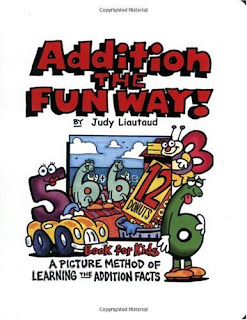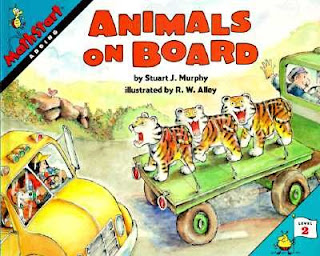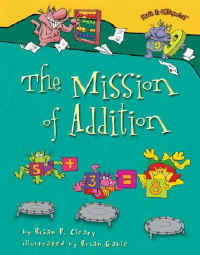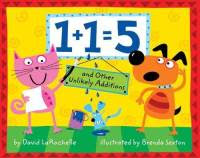Addition is one of the most basic and essential mathematical operations. It is defined as combining more than one set to create a different number. The sum is not always larger than both the addends because negative numbers can be used in addition equations. The plus sign (+) signifies addition, and it is commutative, meaning the order of the addends does not matter; the sum will still be the same.
Books
Addit ion the Fun Way Book for Kids: A Picture Method of Learning the Addition Facts by Judy Liautaud. Illus. Val Chadwick Bagley. 1996. 92p. (9781883841348). Gr. K-2.
ion the Fun Way Book for Kids: A Picture Method of Learning the Addition Facts by Judy Liautaud. Illus. Val Chadwick Bagley. 1996. 92p. (9781883841348). Gr. K-2.
 ion the Fun Way Book for Kids: A Picture Method of Learning the Addition Facts by Judy Liautaud. Illus. Val Chadwick Bagley. 1996. 92p. (9781883841348). Gr. K-2.
ion the Fun Way Book for Kids: A Picture Method of Learning the Addition Facts by Judy Liautaud. Illus. Val Chadwick Bagley. 1996. 92p. (9781883841348). Gr. K-2.With illustrations teaching the 0's-9's addition facts, children will learn addition through cartoons and a story.
An imals on Board by Stuart J. Murphy. Illus. R.W. Alley. Steck-Vaughn. 1999. 32p. (9780739825419). Gr. K-2.
imals on Board by Stuart J. Murphy. Illus. R.W. Alley. Steck-Vaughn. 1999. 32p. (9780739825419). Gr. K-2.
 imals on Board by Stuart J. Murphy. Illus. R.W. Alley. Steck-Vaughn. 1999. 32p. (9780739825419). Gr. K-2.
imals on Board by Stuart J. Murphy. Illus. R.W. Alley. Steck-Vaughn. 1999. 32p. (9780739825419). Gr. K-2.Jill and her dog ride in a truck and are passed by other trucks carrying animals. Join in on the addition fun by adding the number of animals on each truck.
The Hers hey's Kisses Addition Book by Jerry Pallotta. Illus. Rob Bolster. 2001. 32p. (9780439241731). Gr. K-2.
hey's Kisses Addition Book by Jerry Pallotta. Illus. Rob Bolster. 2001. 32p. (9780439241731). Gr. K-2.
 hey's Kisses Addition Book by Jerry Pallotta. Illus. Rob Bolster. 2001. 32p. (9780439241731). Gr. K-2.
hey's Kisses Addition Book by Jerry Pallotta. Illus. Rob Bolster. 2001. 32p. (9780439241731). Gr. K-2.Children will love learning basic addition concepts with this fun and clever book, as a cast of clowns struggle under the weight of life-sized hershey kisses.
The
 Mission of Addition by Brian P. Cleary. Illus. Brian Gable. 2007. First Avenue Additions, (9780822566953). Gr. K-2.
Mission of Addition by Brian P. Cleary. Illus. Brian Gable. 2007. First Avenue Additions, (9780822566953). Gr. K-2.A group of monsters explore what addition is, and how to use it. Children will not only learn how to add by reading this book, but they will see how addition is used in everyday life.
1+1=5 an d Other Unlikely Additions by David LaRochelle. Illus. Brenda Sexton. 2010. Sterling. 32p. (9781402759956). Gr. K-2.
d Other Unlikely Additions by David LaRochelle. Illus. Brenda Sexton. 2010. Sterling. 32p. (9781402759956). Gr. K-2.
 d Other Unlikely Additions by David LaRochelle. Illus. Brenda Sexton. 2010. Sterling. 32p. (9781402759956). Gr. K-2.
d Other Unlikely Additions by David LaRochelle. Illus. Brenda Sexton. 2010. Sterling. 32p. (9781402759956). Gr. K-2.A variety of animals and people explore different types of addition problems, including 1 unicorn horn + 2 goat horns = 3 horns. By reading this book, children will see how addition is used in everyday life.
Websites
Serve aliens lunch when they come up to the table. Solve each addition problem, and serve them the food that corresponds with the sum.
Click on a key and solve the given addition problem to unlock each color. After all problems are answered correctly, color in the vacation picture with the colors you've unlocked.
Help collect the scattered sheep by mentally solving the given addition sentences. But you have to be quick with solving the problems because the sheep are constantly moving!
Help Lucy get all her friends dressed and prepared to shoot a movie. Every ten addition problems solved correctly allows you to dress one of her friends.
Earn hats and clothing for the snowmen by solving basic addition problems. Students are allowed to choose specific number families to work with, or groups of number families to help target their weaknesses.
For Teachers
VA Standards of Learning
1.5: The student will recall basic addition facts with sums to 18 or less and the corresponding subtraction facts.
Background Information from Curriculum Framework:
• Associate the terms addition, adding, and sum with the concept of joining or combining.
VA Standards of Learning
1.5: The student will recall basic addition facts with sums to 18 or less and the corresponding subtraction facts.
Background Information from Curriculum Framework:
• Associate the terms addition, adding, and sum with the concept of joining or combining.
• Provide practice in the use and selection of strategies. Encourage students to develop efficient strategies. Examples of strategies for developing the basic addition and subtraction facts include
– “one-more-than,” “two-more-than” facts;
– “doubles” to recall addition facts (e.g., 2 + 2 =__;
3 + 3 =__); – “near doubles” [e.g., 3 + 4 = (3 + 3) + 1 = __]; – “make-ten” facts (e.g., at least one addend of 8 or
9);
– use of the commutative property, without naming
the property (e.g., 4 +3 is the same as 3 + 4); – use of related facts (e.g., 4 + 3 = 7 , 3 + 4 = 7, 7 –
= 3, and 7 – 3 = 4); – use of the additive identity property (e.g., 4 + 0 =
4), without naming the property but saying, “When you add zero to a number, you always get the original number.”; and
– use patterns to make sums (e.g., 0 + 5 = 5, 1+4=5, 2+3=5,etc.).

No comments:
Post a Comment